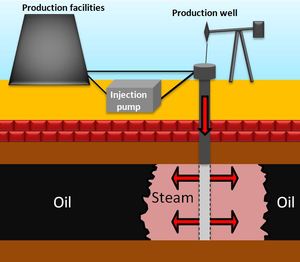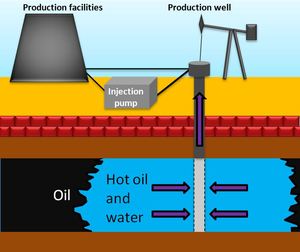

 |
 |
| Fig. 1: Cyclic steam stimulation. Topo: Steam injection. Bottom: Production. (Source: G. Zerkalov) |
The world relies heavily on oil for primary energy. In 2014, the global demand for oil increased by 0.8% to reach 101 million b/d. [1] With constantly rising demand for oil, the question is posed, how will oil producers meet the demand? Oil production is separated into three phases: primary, secondary, and tertiary. Primary recovery involves extracting hydrocarbons that naturally rise to the surface. During the second phase water and gas are injected into the well to push oil to the surface. [2] After the first two phases there can be still 60-80% of oil left in the well. [3] The implementation of enhanced oil recovery (EOR), during the tertiary phase, can help extract up to 30% of original oil in place (OOIP). EOR involves injecting materials that are not normally present in the reservoir to increase production.
During the thermal recovery the reservoir is heated to reduce oil viscosity. Thermal EOR is the most popular method accounting for more than 50% of the overall EOR market. Steam injection is the most common method used in thermal EOR. Other methods include in-situ combustion, where the reservoir is heated and an injected high-oxygen gas mixture burns to create a combustion front. [4] Steam injection is mostly used in shallow reservoirs that contain high viscosity (usually heavy) crude oil. These include reservoirs in the San Joaquin Valley of California or those that comprise the oil sands of Alberta, Canada. Steam injection is a very well understood EOR method, used commercially since the 1960s. The injection of steam lets heat the crude oil in the formation thus lowering its viscosity and vaporizing some of the oil to increase its mobility. [4] The decreased viscosity helps reduce the surface tension, increase the permeability of oil and improve the reservoir seepage conditions. Oil vaporization allows oil to flow more freely through the reservoir and to form better oil once it has condensed.
Steam injection EOR contains two distinct categories: cyclic steam stimulation and steam flooding. In cyclic steam stimulation the same well is used for steam injection and oil production. At first, steam is injected for a period from couple of weeks to a couple of months. The introduced steam allows to heat up the oil immediately surrounding the injection well through convective heating thus lowering its viscosity (Fig. 1).
After the target viscosity is reached, steam injection stops to allow heat to redistribute evenly in the formation. This helps maximize the amount of oil recovered after this stage. The well can then be produced until the temperature in the well drops and the viscosity of oil increases again (Fig. 1). After that, a new cycle of steam injection starts to heat up the reservoir. [5]
 |
| Fig. 2: Steam flooding. (Source: G. Zerkalov) |
In steam flooding, injection and production wells differ from each other. Steam is introduced through the injection wells and is driven toward oil to physically displace it while heating it to reduce viscosity. Steam floods require continuity in the formation to allow steam to drive oil toward the production well (Fig. 2). Steam flooding is more costly that cyclic steaming, since it requires more steam to be used during the process. Nonetheless, this method usually helps recover a larger portion of the oil. In some fields, where connectivity is favored, both methods can be implemented: cyclic stimulation followed by steam flooding. [5]
Steam injection is usually more environmentally friendly than other EOR methods, therefore, fewer complications arise when it is used. The steam itself does not pose a great threat since it just condenses to water, which causes no pollution.
Just as all other EOR methods steam injection has a number of drawbacks and challenges:
When steam cools in the well it turns into water which mixes with oil. This adds extra operational costs since larger volumes of liquids must be handled. Furthermore, an extra dehydration facility is needed nearby to allow for adequate separation of oil and water before oil shipment.
Steam injection can sometimes severely damage the underground well structure. This happens in reservoirs which are prone to geologic rearrangements. This phenomenon can endanger lives of the workers and damage the equipment. Therefore, steam injection cannot be used in these types of reservoirs, unless extra caution is taken.
Economic challenge is one of the determining factors in using steam flooding. When steam injection begins for the first time, one barrel of steam injected can recover up to thirty barrels of incremental oil. After some time, the efficiency of the process drops and one barrel of steam is only able to recover 0.2 barrel of incremental oil. A this point the process becomes uneconomical, since steam price rises up to $20-$30 per barrel of incremental oil recovered, if natural gas is used for steam generation. [5] At these conditions producers usually shut the well until oil prices rise or an another technology is implemented.
Thermal Oil Recovery is by far the most popular method used in the world during the tertiary stage of oil recovery. Steam injection is the most common method used in thermal EOR. It helps produce up to 30% of original oil in place. Steam injection does not poses as many environmental risks as other EOR methods might have. This helps implement this technology in different countries, even with strict regulations. Economy is the main factor that determines if this technology should be implemented in one field or the other.
© Georgy Zerkalov. The author grants permission to copy, distribute and display this work in unaltered form, with attribution to the author, for noncommercial purposes only. All other rights, including commercial rights, are reserved to the author.
[1] "BP Statistical Review of World Energy 2015," British Petroleum, June 2015.
[2] G. Glatz, "A Primer On Enhanced Oil Recovery." Physics 240, Stanford University, Fall 2013.
[3] A. Z. Abidin, T. Puspasari, and W.A. Nugroho, "Polymers For Enhanced Oil Recovery Technology," Procedia Chem. 4, 11 (2012).
[4] "An Introduction To Enhanced Oil Recovery Techniques," Sino Australia Oil and Gas Pty. Ltd., 6 Jun 13.
[5] G. V. Chilingar, J. O Robertson, and S Kumar, Eds., Surface Operations In Petroleum Production, II (Elsevier, 1989), pp. 238-244.